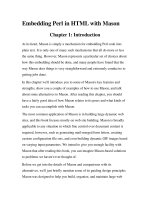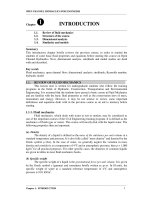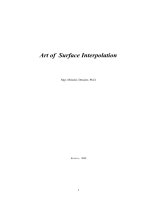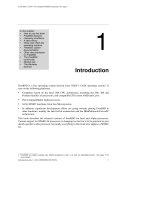Chapter 1 introduction
Bạn đang xem bản rút gọn của tài liệu. Xem và tải ngay bản đầy đủ của tài liệu tại đây (316.76 KB, 26 trang )
OPEN UNIVERSITY HCMC
MBA PREPARATORY COURSE
Principles of Financial
Accounting
Lecturer: NGUYEN TAN BINH
Chapter 1
Introduction
to Accounting
06/04/16
NGUYEN TAN BIN
2
Learning Objectives
After studying this chapter, you should be able to:
Explain how accounting information assists in
making decisions.
Describe the components of the balance sheet.
Analyze business transactions and relate them to
changes in the balance sheet.
Classify operating, investing, and financing
activities in a cash flow statement.
06/04/16
NGUYEN TAN BIN
3
Introduction
Accounting - a process of identifying,
recording, summarizing, and reporting
economic information to decision makers in
the form of financial statements
Financial accounting - focuses on the
specific needs of decision makers external
to the organization, such as stockholders,
suppliers, banks, and government agencies
06/04/16
NGUYEN TAN BIN
4
The accounting system
The accounting system is a series of
steps performed to analyze, record,
quantify, accumulate, summarize,
classify, report, and interpret economic
events and their effects on an
organization and to prepare the financial
statements.
06/04/16
NGUYEN TAN BIN
5
The accounting system
Accounting systems are designed to meet
the needs of the decision makers who use
the financial information.
Every business maintains some type of
accounting system.
These accounting systems may be very
complex or very simple, but the real value of
any accounting system lies in the information
that the system provides.
06/04/16
NGUYEN TAN BIN
6
Accounting as an Aid to
Decision Making
Accounting information is useful to anyone
who makes decisions that have economic
results.
•
•
•
•
•
Managers want to know if a new product will be
profitable.
Owners want to know which employees are
productive.
Investors want to know if a company is a good
investment.
Legislators want to know how a proposed law will
affect budgets.
Creditors want to know if they should extend
credit, how much to extend, and for how long.
06/04/16
NGUYEN TAN BIN
7
Accounting as an Aid to
Decision Making
Accounting helps in decision making by showing
where and when money has been spent, by
evaluating performance, and by showing the
implications of choosing one plan instead of
another.
Fundamental relationships in the decision-making
process:
Transaction
(Event)
Accountant’s
recording
06/04/16
Financial
statements
NGUYEN TAN BIN
Users
8
Financial accounting and
Management accounting
The major difference between financial
and management accounting is the
users of the information.
Financial accounting serves external
users, such as investors, creditors, and
suppliers.
Management accounting serves
internal users, such as executives,
managers, and administrators
within organizations.
06/04/16
NGUYEN TAN BIN
9
Financial accounting and
Management accounting
The primary questions about an
company’s success that decision makers
want to know are:
(i) What is the financial picture of the
company on a given day?
(ii) How well did the company do during a
given period?
06/04/16
NGUYEN TAN BIN
10
Financial accounting and
Management accounting
Accountants answer these primary
questions with three major financial
statements.
Balance sheet – shows financial picture
on a given day
Income statement – shows performance
over a given period
Statement of cash flows – shows
performance over a given period
06/04/16
NGUYEN TAN BIN
11
The Balance Sheet
The balance sheet shows the financial
position of a company at a particular point
in time.
The balance sheet is sometimes referred to as
the statement of financial position or the
statement of financial condition.
The left side lists assets – the right side
lists liabilities and owners’ equity
06/04/16
NGUYEN TAN BIN
12
The Balance Sheet
The balance sheet equation:
Assets = Liabilities + Owners’ Equity
or
Owners’ Equity = Assets - Liabilities
06/04/16
NGUYEN TAN BIN
13
The Balance Sheet
Elements of the balance sheet:
Assets - resources of the firm that are expected
to increase or cause future cash flows (everything
the firm owns)
Liabilities - obligations of the firm to outsiders or
claims against its assets by outsiders (debts of the
firm)
Owners’ Equity - the residual interest in, or
remaining claims against, the firm’s assets after
deducting liabilities (rights of the owners)
06/04/16
NGUYEN TAN BIN
14
The Balance Sheet
SAIGON MILK COMPANY
Balance Sheet, December 31, 2005 (in millions VND)
Assets
Current assets:
Cash
Accounts receivable
Total current assets
Plant assets:
Land
Equipment
Total plant assets
Total assets
06/04/16
Liabilities and OE’s
$ 400
450
$ 850
$ 1,200
800
2,000
$ 2,850
Current liabilities:
Accounts payable
Wages payable
Total liabilities
Owner’s Equity
$ 800
120
$ 920
1,930
Total liabilities and
owner’s equity
$ 2,850
NGUYEN TAN BIN
15
Balance Sheet Transactions
The balance sheet is affected by every
transaction that an entity encounters.
Each transaction has counterbalancing
entries that keep total assets equal to
total liabilities and owners’ equity, i.e.,
the balance sheet equation and the
balance sheet must always be
balanced.
06/04/16
NGUYEN TAN BIN
16
Transaction Analysis
Transactions are recorded in accounts, which are summary records of the
changes in particular assets, liabilities, or owners’ equity.
The account balance is the total of all entries to the account.
06/04/16
NGUYEN TAN BIN
17
Transaction Analysis
For each transaction, the accountant determines:
Which specific accounts are affected
Whether the account balances are
increased or decreased
The amount of the change in each
account
06/04/16
NGUYEN TAN BIN
18
Transaction Analysis
Some definitions to remember:
Inventory - goods held by a firm for resale
to customers
Account payable - a liability that results
from the purchase of goods or services on
account
Compound entry - a transaction that
affects more than two accounts
Creditor - one to whom money is owed
Debtor - one who owes money
06/04/16
NGUYEN TAN BIN
19
Introduction to
Cash Flows Statement
Companies do three basic things.
They invest in assets to conduct business.
They raise money to finance these assets.
They use the assets and the money they raise
to operate the business.
These transactions can be classified into
one of three categories – operating,
investing, and financing activities.
06/04/16
NGUYEN TAN BIN
20
Introduction to
Cash Flows Statement
Operating activities – include sale and
purchase of goods and payment of items
such as rent, taxes, and interest
Investing activities – include acquiring
and selling assets and securities held for
investment purposes
Financing activities – include obtaining
resources from owners and creditors and
repaying amounts borrowed
06/04/16
NGUYEN TAN BIN
21
Introduction to
Cash Flows Statement
The statement of cash flows gives a direct
picture of where cash came from and where
cash went.
Preparation of the statement of cash flows
List the activities that increased (inflow) or
decreased (outflow) cash.
Place each inflow or outflow into the proper
categories.
06/04/16
NGUYEN TAN BIN
22
Types of Ownership
Three basic forms of ownership:
Sole proprietorships
Partnerships
Corporations
06/04/16
NGUYEN TAN BIN
23
Accounting for Owners’ Equity
Proprietorships and Partnerships vs. Corporations
Owners’ equities for proprietorships and partnerships are called capital.
Owners’ equity for a corporation
shareholders’ equity.
06/04/16
is called stockholders’ equity or
NGUYEN TAN BIN
24
Accounting for Owners’ Equity
In a corporation, the total capital investment actively invested by the owners is
called paid-in capital.
Paid-in capital consists of two parts:
Capital stock at par value
Paid-in capital in excess of par value
06/04/16
NGUYEN TAN BIN
25









